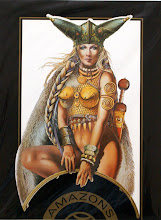It isn't often you will get to see a complete strip as it was originally drawn, so this will be a bit of a treat as the Illustration Art Gallery has all nine pages of "Mr. Tomorrow", a thriller about a time-travelling criminal from the year 2971. But before we get to that, let's meet the artist...
Matías Alonso Andrés was born in Valle de Trapagaran (Euzkadi), near the Bay of Biscay in northern Spain, in 1935. An illustrator and painter from childhood, he won a Segundo Premio Nacional de Pintura (Second National Painting Prize) at the age of 16. He made his comic book debut in the pages of Colorin and Azucena but established himself at the age of 18 when he began drawing El Charro Termerario (1953), written by Pedro Muñoz for Barcelona-based Editora Grafidea. The character Juan Miguel, known as El Charro the bold, was first to be found in the wild west of Mexico and California, often fighting on behalf of the Aztec Indians. After 44 issues, Muñoz and Alonso changed the focus of the strip from Juan Miguel to a secondary character introduced to the strip, the teenage Flaviano, and his friend Knut.
The new series, La Capitana (1955), was set on the high seas and around the globe, from Africa to Australia, and Alonso could be seen developing as an artist: Jaume Salva i Lara has commented (and I'm paraphrasing because I know almost no Spanish and online translators are, at best, a little sloppy) that Alonso's artwork had taken on a lot of personality, the ships and military uniforms (such as those of the French foreign legion) drawn with an eye for detail and the exotic settings showing the influence of Hollywood movies. To counter this rather thankless attention to realism, Alonso tried to make the pages stylistically interesting, although the results could be somewhat mannered.
After a further 44 issues, the focus changed again. Now married (although his wife falls ill and is soon left behind), Flaviano travels to India for his next adventure, El Amuleto Verde (1956; The Green Amulet), a somewhat disappointing finale to the trilogy as the artwork became hurried and less detailed, the action bowdlerised and the storyline less interesting. It was brought to an end after 24 weeks.
Alonso went on to draw more historical strips Jarko, el Temible (20 episodes, 1957) and Luis Valiente (24 episodes, 1957) before adapting a series of science fiction stories, commonly known as 'La saga de los Aznar', written by George H. White (the pen-name of Spanish author Pascual Enguídanos Usach, 1923-2006), into comics, producing 44 issues under the title Hazañas de la Juventud Audaz (Daring Feats of Youth), published by Editora Valenciana in 1959-60.
Alonso then took over the artwork of the famous Spanish historical strip El Guerrero del Antifaz (The Warrior of the Mask) in 1961, which he drew in the style of the strip’s originator, Manuel Gago. He continued the adventures for 80 issues before Gago returned to the series. To some fans of the famous strip Alonso's artwork, influenced by Gago from the start, was a disappointing hiatus in a series that belonged to Gago; others consider the episodes featuring the clean, precise line of Alonso's artwork and storylines by Vincente Tortajada to be amongst the best.
It was around this period that Alonso began working with Luis Bermejo, a Valencian artist who was one of the leading lights of Spanish comics (Aventuras del FBI, Apache). Alonso began working for D.C. Thomson's Commando in 1962 (probably via Bermejo and Selecciones Illustrades) whilst continuing to work locally, drawing various episodes of Espíritu del Oeste (1963, written by Pedro Quesada) for the Spanish publisher Maga. Alonso also drew "La isla del Tesoro" (1964) for the magazine Flecha Roja and Las Aventuras de Marco Polo (1964) for Pantera Negra, the latter with Bermejo who, at that time, was also drawing "Heros the Spartan" for Eagle.
In Spain, Alonso collaborated with Bermejo on illustrations for children’s books such as Vida y Costumbres de los Vikingos and África y sus habitantes (1965). By the mid-1960s he was firmly established in the UK market, drawing for Commando, Battle Picture Library, Air Ace Picture Library and War Picture Library, sometimes working in collaboration with Bermejo and with Eustaquio Segrelles. A fine example of his collaborative work with Bermejo can be seen in the "Heros" strip that appeared in Eagle Annual 1967, although his contributions to Boys World Annual 1968 and especially the 1969 volume, show what he was capable of working solo.
From 1967 he became a regular contributor to Victor, drawing dozens of weekly strips over the next 23 years. Often to be found drawing historical or war adventures, the titles alone offer an insight to the range of strips he drew: "Johnny Gurka", "The Lost Warriors of Tartary", "Task Force with Tusks", "Jungle Joe", "The Planet Seekers", "Vengeance Stalks the Veldt", "The Sons of Ra", "The Wild Colonial Boy", "The White Tiger", "Wings of Death", "Eagle of the Rising Sun" and "The Haunting of Running Bear".
Alonso also drew occasional strips outside of the pages of Victor and Commando, including a handful of stories for girls' comics Judy, Diana, Debbie and Emma and the boys' adventure comic Bullet ("Claws of Terror") in the 1970s.
His last known contributions to British comics appeared in the early 1990s when he drew strips for Judy Picture Library and Teenage Mutant Ninja Turtles. By then Alonso had established himself in Spain as a painter--noted for his landscapes of northern Spain and of Spanish ports with boats jostling in the water--and has had his work exhibited in Barcelona and Madrid.
So... here for your pleasure is the complete "Mr. Tomorrow", which originally appeared in Pow Annual 1971.
All nine pages are available for purchase here.
(* Mr. Tomorrow © IPC Magazines.)
Subscribe to:
Post Comments (Atom)




























No comments:
Post a Comment